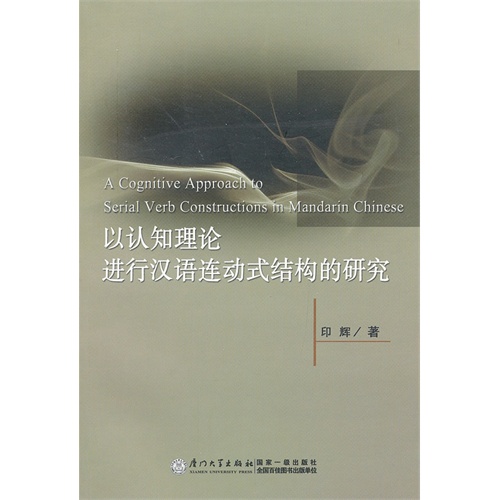- ISBN:9787561545270
- 装帧:一般胶版纸
- 册数:暂无
- 重量:暂无
- 开本:大32开
- 页数:179
- 出版时间:2012-12-01
- 条形码:9787561545270 ; 978-7-5615-4527-0
本书特色
《以认知理论进行汉语连动式结构的研究》旨在解决汉语语言学的一个长期存在的问题,即如何分类和理解svc(汉语连动式结构)。作者对svc的分类是基于三形象语义原则:时间序列和范围,共享参与者,和情境依赖。
内容简介
Thisstudyaimsatsolvingalong-standingprobleminMandarinlinguistics,namelyhowtocategorizeandunderstandtheplethoraofconstructionsthathavebeencalledSVCs(SerialVerbConstructions)atonetimeoranother.Thisstudyexaminesfeatureswhichdifferentiatethemfromtypicalcasesofcoordination,subordination.ItdemonstratesthatthemaindifferencesbetweenSVCsandnon-SVCslieintheirdifferentprofiles.MyclassificationforanSVCisbasedonthethreeiconicallybasedsemanticprinciples:temporalsequenceandscope,sharedparticipants,andsituationaldependence.Groundedonthesethreeprinciples,sevenmorphosyntacticanclprosodictestshavebeenproposedtoapplytofiveconstructionswhichconsistofmorethanoneverb.Thesevenoperationaliconic/semantictestsallowustocapturecommonfeaturesofSVCsinMandarinChinese.MandarinSVCsreflectcognitivepackaging,thatis,anSVCdenotesaunitarycomplexeverntandreflectseventconflationoftwoormoresub-events.ThefiveconstructionsreflectdegreesofserializationoracontinuumofeventconflationinMandarin.Inthisstudy,twoexperimentsweredesignedtoexplorethephenomenonofeventautonomyoreventconflationofthefive[V(N)V...]typesandtheeffectsofconstrualontheinterpretationofdifferentconstructions.ThefindingsintheexperimentssuggestthatMandannspeakersaresensitivetosentencesexhibitingdifferentdegreesofeventconflation.Theresultsintheexperimentsindicatethateventconflationreallyt.urnedouttobeagradedratherthanadiscretePhenomenon.ThephenomenaofManclarinSVCsprovideevidenceforakindoficonicityoperatinginthecodingofmulti-verbstructures.
目录
chapter 1 introductionchapter 2 past treatments of serial verb constructions 2.1 past approaches to svcs 2.1.1 christaller (1875) 2.1.2 westermann (1930) 2.1.3 stewart ( 1963 ) 2.1.4 bamgbose (1974) 2.1.5 baker (1989) 2.1.6 agbedor (1994) 2.1.7 aikhenvald ( 2006 ) 2.2 past approaches to chinese svcs 2.2.1 chao (1968) 2.2.2 li and thompson ( 1981 ) 2.2.3 dai (1990) 2.2.4 paul (2004) 2.3 discussionchapter 3 basic tenets of cognitive grammar 3.1 assumptions of cognitive grammar 3.2 symbolization 3.3 construction and composition 3.4 base vs.profile 3.5 construal 3.6 perspective 3.7 action chain 3.8 lexicon and syntax 3.9 schematic representation of a transitive eventchapter 4 the present analysis 4.1 three iconically based semantic principles 4.1.1 principle of temporal sequence and scope 4.1.2 principle of shared participants 4.1.3 principle of situational dependence 4.2 conceptual event 4.3 laying out the event conflation continuum 4.4 event structure of coordination, subordination, and svcs 4.5 morphosyntactic and prosodic tests of event conflation chapter 5 the five constructions and the seven tests 5.1 coordinate constructions 5.1.1 schematic representation 5.1.2 application of tests 5.1.3 discussion 5.2 complement constructions 5.2.1 schematic representation 5.2.2 application of tests 5.2.3 discussion 5.3 purposive constructions 5.3.1 purposive complements or separate clauses 5.3.2 the three principles reflected in purposive svcs 5.3.3 schematic representation 5.3.4 application of the tests 5.3.5 discussion 5.4 double-headed or shared object constructions 5.4.1 the three principles reflected in double-headedconstructions 5.4.2 schematic representation 5.4.3 application of tests 5.4.4 discussion 5.5 the so-called vv compounds--a continuum between lexicon andsyntax 5.5.1 parallel vv compounds 5.5.2 phase vv compounds 5.5.3 resultative vv compounds 5.5.4 directional vv compounds 5.6 vv compounds as svcs 5.6.1 svcs with complements of result 5.6.2 svcs with complements of direction 5.6.3 schematic representation 5.6.4 application of tests 5.7 discussionchapter 6 coverb constructions 6.1 traditional criteria 6.2 problematic criteria 6.3 verbhood tests 6.4 present analysis 6.4.1 coverbs--a continuum 6.4.2 entities undergoing process 6.5 metaphorical and functional extensions 6.5.1 na 'take' ——instrumental and topic marker 6.5.2 ba——object marker 6.5.3 gel (give) ——recipient marker and benefactive use 6.6 differences between svcs and covcschapter 7 psycholinguistic experiments 7.1 experiment one 7.2 experiment twochapter 8 the association of multi-verb constructions with verbs 8.1 coordinate construction 8.2 complement construction 8.3 purposive construction 8.4 shared object construction 8.5 compound construction 8.5.1 contiguous compounds containing lai ' come' and qu ' go' 8.5.2 contiguous compounds containing motion verbs other thanlai and quchapter 9 conclusionsbibliography
-

蛤蟆先生去看心理医生
¥14.1¥38.0 -

身为女性的选择
¥19.0¥56.0 -

咬文嚼字二百问
¥11.7¥32.0 -

乌合之众:大众心理研究
¥12.9¥36.8 -

性心理学
¥19.7¥58.0 -

饥饿、富裕与道德
¥11.3¥45.0 -

张舜徽集清人笔记条辨
¥13.4¥32.0 -

乡土中国
¥12.2¥26.0 -

遇见天堂鸟
¥13.5¥45.0 -

语文闲谈
¥12.2¥29.0 -

看不见的伤痕(八品-九品)
¥22.1¥69.0 -

中国人的名·字·号
¥9.0¥28.0 -

非暴力沟通心理学 : 用非暴力沟通化解冲突
¥9.0¥36.0 -

理解生命
¥9.8¥32.8 -

我们时代的神经症人格
¥14.7¥46.0 -

世界尽头的咖啡馆
¥18.5¥45.0 -

自卑与超越
¥14.7¥39.8 -

汉字王国
¥11.5¥46.0 -

非暴力沟通(修订版)
¥40.1¥59.8 -

我们内心的冲突
¥15.5¥42.0













